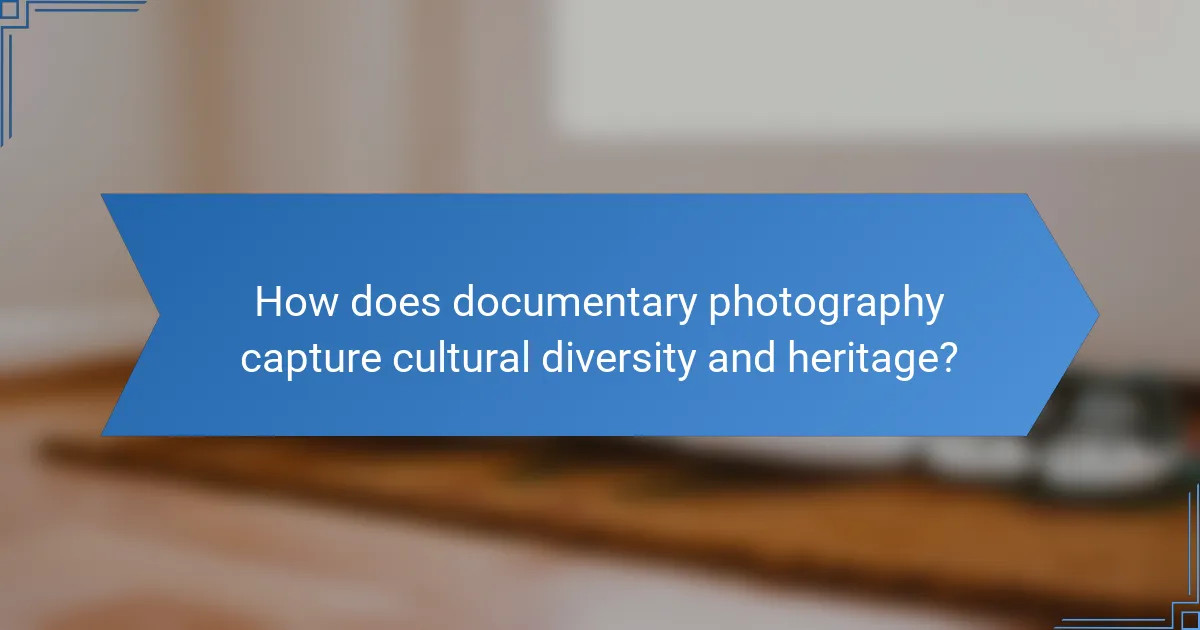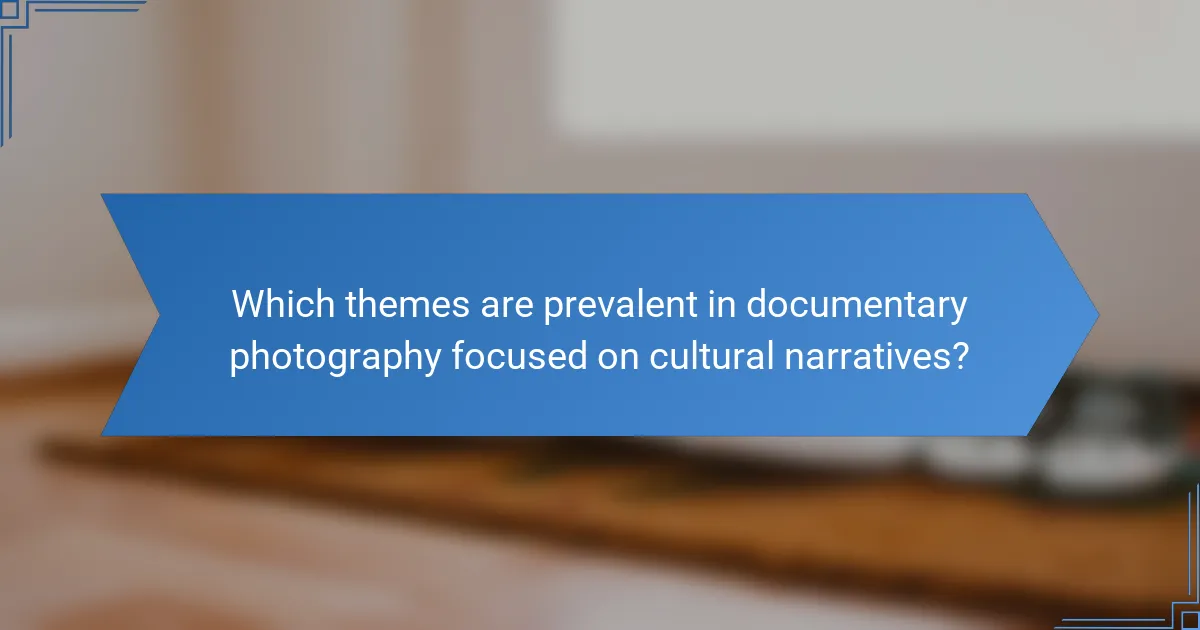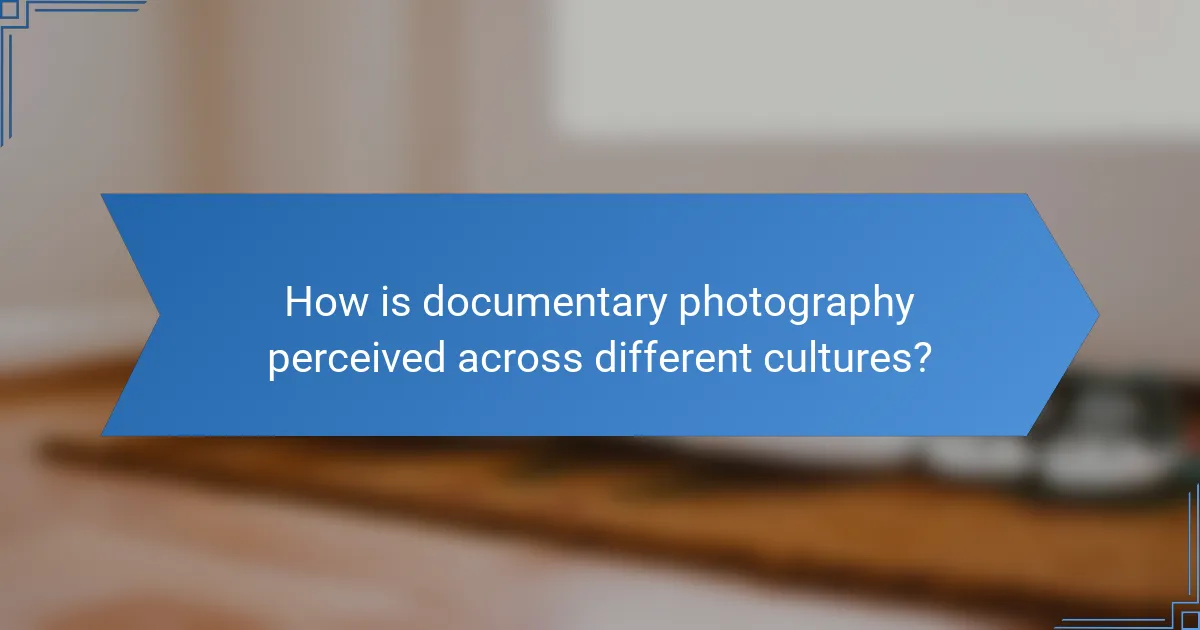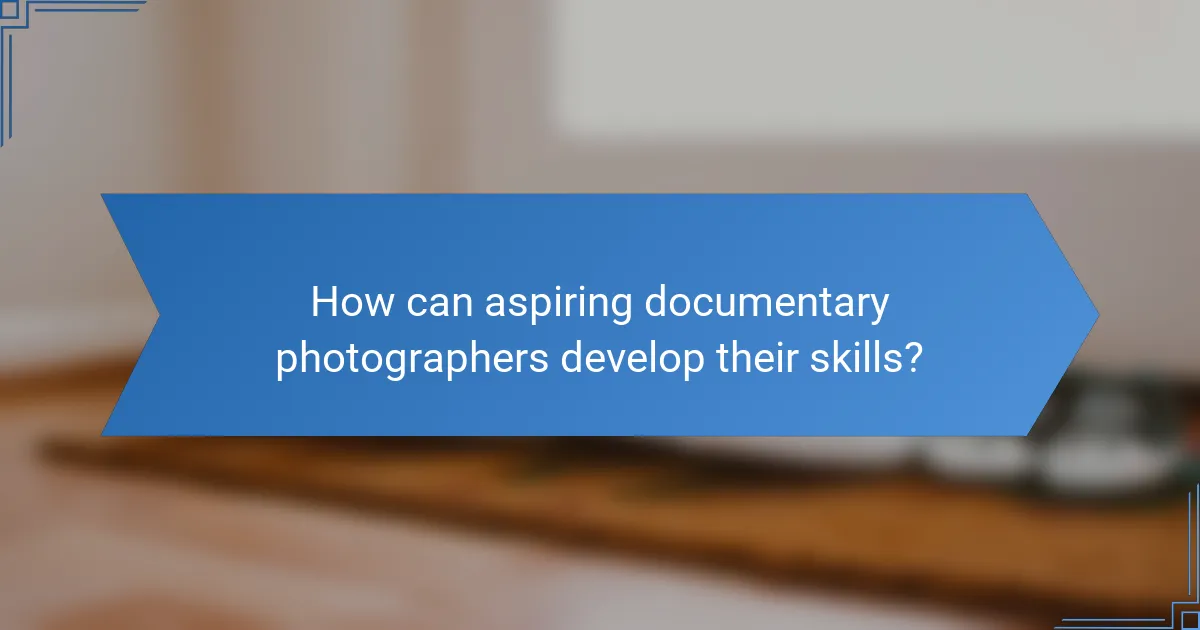Documentary photography captures the essence of cultural diversity and heritage by showcasing real-life stories and experiences. It emphasizes themes of identity, tradition, and social justice while addressing ethical considerations in representation. This genre reflects varying perceptions across cultures and highlights the work of notable photographers who have influenced cultural representation. Emerging trends focus on underrepresented communities, environmental issues, and the integration of personal narratives to foster empathy and connection.

How does documentary photography capture cultural diversity and heritage?
Documentary photography effectively captures cultural diversity and heritage by showcasing real-life stories and experiences. This form of visual storytelling highlights unique traditions, customs, and lifestyles, offering an authentic glimpse into different cultures. Through powerful imagery, documentary photographers convey the essence of communities, preserving their histories and identities for future generations. This approach fosters understanding and appreciation of the world’s rich tapestry of cultures, emphasizing shared human experiences while celebrating distinct differences.
What techniques are used in documentary photography?
Documentary photography employs techniques like candid shooting, storytelling through composition, and using natural light. These methods capture authentic moments and convey cultural narratives. Photographers often focus on subjects’ emotions and interactions, emphasizing the unique attributes of diverse communities. Techniques like environmental portraiture highlight the connection between individuals and their surroundings, revealing heritage and identity.
Why is storytelling important in documentary photography?
Storytelling is crucial in documentary photography as it captures and conveys cultural diversity and heritage. Through visual narratives, photographers evoke emotions and foster understanding. This approach highlights unique attributes of communities, showcasing their traditions and challenges. Effective storytelling in this medium fosters empathy, connecting viewers to diverse experiences and perspectives. As a result, it preserves cultural identity and promotes appreciation for global diversity.

Which themes are prevalent in documentary photography focused on cultural narratives?
Documentary photography focused on cultural narratives often emphasizes themes of identity, tradition, and social justice. These themes highlight the diversity of human experiences and the importance of preserving cultural heritage. The portrayal of marginalized communities is a unique attribute that distinguishes this genre, showcasing their stories and struggles. Additionally, the use of visual storytelling creates an emotional connection, making the narratives more impactful. Cultural exchange and representation are rare attributes that further enhance the depth of these photographs, fostering understanding and empathy among viewers.
How do social issues influence documentary photography?
Social issues significantly shape documentary photography by highlighting cultural diversity and heritage. Photographers often focus on social injustices, migration, and community struggles, using their work to raise awareness and provoke dialogue. This medium captures authentic narratives, revealing the complexities of human experience and fostering empathy. As a result, documentary photography serves as a powerful tool for social change, encouraging viewers to engage with different cultures and perspectives.
What role does identity play in visual storytelling?
Identity plays a crucial role in visual storytelling by shaping narratives and perspectives. In documentary photography, identity influences how cultural diversity and heritage are represented. Photographers capture unique attributes of communities, highlighting their experiences and traditions. This approach fosters a deeper understanding of cultural nuances and challenges stereotypes. Effective visual storytelling allows viewers to connect emotionally, enhancing empathy and appreciation for diverse identities.

What are the ethical considerations in documentary photography?
Ethical considerations in documentary photography include respect for subjects, informed consent, and cultural sensitivity. Photographers must navigate power dynamics and avoid exploitation. They should represent communities authentically, ensuring their narratives are not distorted. Transparency about intent fosters trust and integrity in storytelling.
How do photographers navigate consent and representation?
Photographers navigate consent and representation by prioritising ethical practices and community engagement. They seek informed consent from subjects, ensuring that individuals understand how their images will be used. This approach fosters trust and respect, crucial in documentary photography that highlights cultural diversity and heritage.
Additionally, photographers often collaborate with communities to depict authentic narratives. This collaboration allows for a representation that honours cultural identities and stories. By engaging subjects in the storytelling process, photographers can address potential biases and misrepresentations.
Cultural sensitivity is another critical aspect. Photographers must be aware of the historical contexts and power dynamics involved in their work. This awareness helps them avoid exploitative practices and ensures that the subjects’ voices are amplified rather than overshadowed.
Ultimately, navigating consent and representation in documentary photography requires a commitment to ethical storytelling, respect for subjects, and a collaborative approach that values cultural heritage.
What impact does cultural sensitivity have on documentary projects?
Cultural sensitivity significantly enhances documentary projects by fostering authentic representation of diverse communities. It ensures respectful engagement with subjects, leading to more meaningful narratives. Projects that prioritise cultural sensitivity often reflect deeper understanding and appreciation of heritage, which resonates with audiences. For example, documentaries featuring local voices and perspectives can challenge stereotypes and promote inclusivity, enriching the overall storytelling experience.

How is documentary photography perceived across different cultures?
Documentary photography is perceived differently across cultures, reflecting diverse values and narratives. In some cultures, it serves as a tool for social change, highlighting injustices and raising awareness. In others, it focuses on preserving traditions and heritage, celebrating cultural identity.
For instance, in Western contexts, documentary photography often emphasizes individual stories and emotional depth. In contrast, many Indigenous cultures utilize it to document communal experiences and ancestral connections. This divergence illustrates how cultural backgrounds shape the interpretation and significance of documentary photography.
Moreover, the accessibility of technology influences perceptions. In urban areas, documentary photography may be seen as a form of art, while in rural regions, it might be viewed primarily as a means of storytelling. This variation underscores the role of context in shaping how documentary photography is valued and understood.
Ultimately, documentary photography acts as a mirror reflecting cultural diversity, with its impact varying based on local customs, historical contexts, and societal needs.
What are the challenges faced by photographers in various regions?
Photographers face various challenges in documentary photography across regions. These include cultural sensitivity, access to subjects, and varying legal restrictions.
Cultural sensitivity is crucial as photographers must navigate differing customs and traditions. Access to subjects can be limited by geographical barriers or local regulations. Legal restrictions may vary significantly, impacting the ability to capture images freely.
Additionally, photographers often deal with language barriers, which can hinder communication with subjects and communities. Economic conditions can also affect the resources available for projects, influencing the quality and reach of their work.
Understanding these challenges is essential for effectively telling stories of cultural diversity and heritage.
How do local customs shape the approach to documentary photography?
Local customs significantly influence documentary photography by shaping the narratives and perspectives captured. Photographers often adapt their techniques to resonate with cultural values and traditions. For instance, the use of specific symbols or colours can reflect local beliefs, enhancing the storytelling aspect. Furthermore, customs dictate the subjects chosen for documentation, focusing on community events, rituals, or daily life that hold cultural significance. This approach fosters a deeper connection between the photographer and the subjects, ensuring authenticity in representation. Ultimately, local customs enrich the visual language of documentary photography, making it a powerful tool for cultural preservation.

Which notable documentary photographers have shaped the field?
Notable documentary photographers include Henri Cartier-Bresson, Dorothea Lange, and Sebastião Salgado. Their work profoundly influenced cultural representation and visual storytelling. Cartier-Bresson pioneered the concept of the “decisive moment,” capturing fleeting instances that reveal deeper truths. Lange’s images during the Great Depression highlighted human suffering and resilience, shaping public perception of social issues. Salgado’s powerful imagery of migration and environmental degradation emphasizes global challenges and cultural heritage. These photographers have left a lasting legacy, enriching the field of documentary photography.
What unique perspectives do they bring to cultural storytelling?
Documentary photographers offer unique perspectives on cultural storytelling by capturing authentic moments that reflect diverse heritage. Their work emphasizes emotional connections and personal narratives, often showcasing underrepresented communities. This approach fosters empathy and understanding, enriching the viewer’s appreciation of cultural diversity. By using visual storytelling techniques, they highlight the intricate details of everyday life, transforming ordinary scenes into powerful narratives.
How have their works influenced public perception of cultural diversity?
Documentary photography significantly shapes public perception of cultural diversity by highlighting underrepresented narratives. These photographs serve as powerful visual stories that foster empathy and understanding. They challenge stereotypes and promote appreciation for different cultures. For instance, works by renowned photographers like Steve McCurry and Sebastião Salgado bring global attention to cultural heritage, showcasing the richness and complexity of diverse communities. Their images often spark conversations about inclusion and social justice, influencing how society perceives and values cultural diversity.

What are the emerging trends in documentary photography?
Emerging trends in documentary photography focus on cultural representation and social justice. Photographers increasingly highlight underrepresented communities, using visual storytelling to advocate for change.
The rise of digital platforms allows for broader exposure, enabling diverse voices to share their narratives. Additionally, immersive technologies like virtual reality are transforming how audiences experience these stories.
Environmental issues are also becoming central themes, as photographers document the impact of climate change on cultural heritage. Collaborative projects between artists and communities are fostering deeper connections and understanding.
Finally, the integration of personal narratives adds authenticity, inviting viewers to engage with the subjects’ lived experiences. This trend emphasizes empathy and connection in documentary photography.
How is technology changing the landscape of documentary photography?
Technology is transforming documentary photography by enhancing storytelling and accessibility. Digital tools allow photographers to capture diverse cultures and heritage with improved clarity and depth. Social media platforms amplify visibility, enabling wider audiences to engage with these narratives. Additionally, advancements in editing software facilitate creative expression, allowing unique perspectives to emerge. As a result, documentary photography evolves, reflecting the dynamic nature of cultural representation in the digital age.
What new platforms are being used to share documentary work?
New platforms for sharing documentary work include social media, streaming services, and digital storytelling websites. These platforms enhance visibility and accessibility for diverse cultural narratives. Instagram and TikTok are popular for short-form documentaries, while platforms like Vimeo and YouTube cater to longer formats. Additionally, websites dedicated to documentary storytelling, such as DocuWiki, provide curated spaces for in-depth exploration of cultural heritage.

How can aspiring documentary photographers develop their skills?
Aspiring documentary photographers can develop their skills through practice, education, and community engagement. Regularly photographing diverse cultural events enhances storytelling ability. Participating in workshops provides technical knowledge and feedback. Networking with other photographers fosters collaboration and inspiration. Analyzing renowned documentary works deepens understanding of narrative techniques.
What are the best practices for effective storytelling through photography?
To effectively tell stories through documentary photography, focus on authenticity, emotional connection, and cultural context. Capture genuine moments that reflect the diversity and heritage of subjects, using light and composition to enhance storytelling. Engage with your subjects to build trust, allowing their narratives to unfold naturally. Experiment with different perspectives and techniques to convey depth and meaning, ensuring each image resonates with viewers.
Which common mistakes should photographers avoid in their work?
Photographers should avoid common mistakes that hinder effective storytelling in documentary photography. Failing to research subjects can lead to misrepresentation of cultural diversity. Neglecting to build rapport with subjects may result in less authentic images. Overlooking composition techniques can weaken visual impact. Lastly, ignoring the importance of context can diminish the narrative power of the photographs.
What resources are available for learning documentary photography?
Various resources are available for learning documentary photography, including online courses, books, and workshops. Online platforms like MasterClass and Coursera offer structured lessons from experienced photographers. Books such as “Documentary Photography: A History of the Photographic Image in the Making” provide valuable insights into the genre’s evolution. Local photography schools often host workshops that focus on practical skills and real-world applications. Additionally, joining photography communities and forums can facilitate peer learning and feedback.